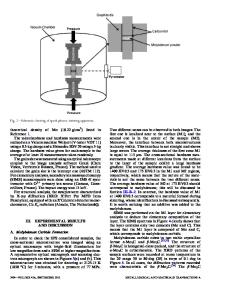Spark Plasma Sintering of Titanium Spherical Particles
- PDF / 1,123,354 Bytes
- 7 Pages / 593.972 x 792 pts Page_size
- 104 Downloads / 461 Views
ODUCTION
SPARK Plasma Sintering (SPS), and its variants, field-assisted sintering technology (FAST),[1,2] electric pulse sintering (EPS),[3] pulsed electric current sintering (PECS),[4] electric discharge sintering (EDS),[5,6] and plasma-activated sintering (PAS)[7] are special techniques for effective consolidation of powders. The first patent for equipment that heated and sintered powders by passing DC electric current through the sintering media was issued in 1906.[8] However, intensive investigations and the consequent development of the spark plasma sintering technique only started in the early 1960s.[9] SPS densification is performed by simultaneous application of uniaxial pressure and a low-voltage direct-pulsed current of a few thousand amperes.[10] Based on the hypothesis proposed by Tokita,[11] heat is produced by two mechanisms: (i) high-temperature plasma (spark plasma) is generated within the gaps between particles by electrical discharge throughout ON-OFF DC pulsing; (ii) Joule heating, resulting from electrical resistance of the graphite tools and the powder compact (in the case of conductive materials). Research into the SPS field has increased dramatically in the past decade; attention has been drawn to both the fundamental and the applied levels of this technique.[12] It should be noted that the sintering mechanism,
MOHAMMAD ABEDI, Student of Master Program, DMITRY O. MOSKOVSKIKH, Scientist, and ALEXANDER S. ROGACHEV, Professor, are with the Center of Functional Nano-Ceramics, National University of Science and Technology, MISIS, Moscow 119049, Russia. ALEXANDER S. MUKASYAN, Professor, is with the Department of Chemical and Biomolecular Engineering, University of Notre Dame, Notre Dame, IN 46556, USA. Contact e-mail: [email protected] Manuscript submitted August 23, 2015. METALLURGICAL AND MATERIALS TRANSACTIONS B
particularly the formation of plasma, is still inconclusive, but has both supporters[13] and opponents.[14] Based on a literature analysis, it can be concluded SPS offers several advantages over conventional sintering and consolidation techniques, which are divided into two groups[12]: (a) the intrinsic method advantages, and (b) the enhanced material properties consolidated by this method. In the former category, the following merits can be cited: fast heating rates,[15] shorter sintering times,[16] lower sintering temperatures,[17] achievement of higher densities at the same temperatures,[18] minimizing material loss due to vaporization,[19] and limited grain growth.[20] In the latter group, there are enhanced magnetic properties[21] and reduced impurity segregation at grain boundaries.[22] As a consequence, SPS has become a highly regarded candidate for consolidation of a wide variety of materials, as detailed in Reference 23. Although the SPS technique has proven to be effective for the fabrication of a variety of materials, the limited scientific background is available on the sintering mechanism.[24] The reasons that lead to the high material sintering efficiency of this process have been att
Data Loading...











